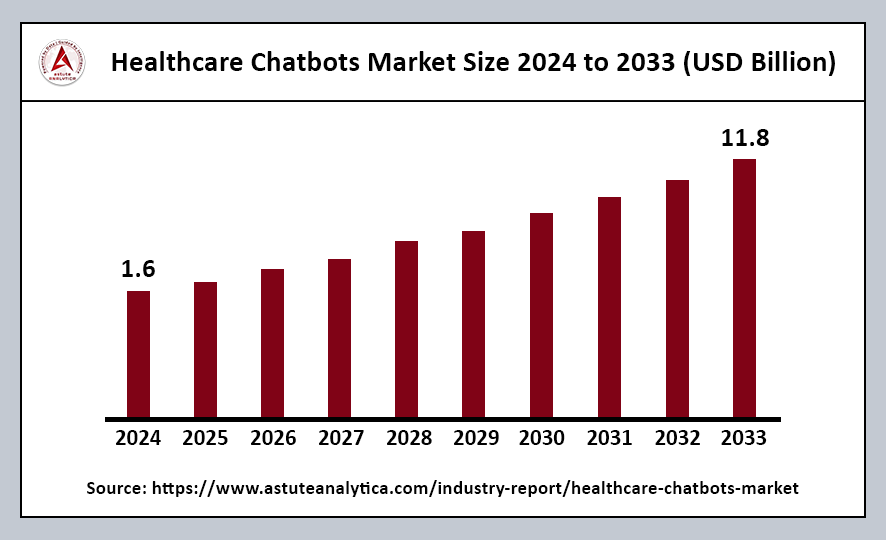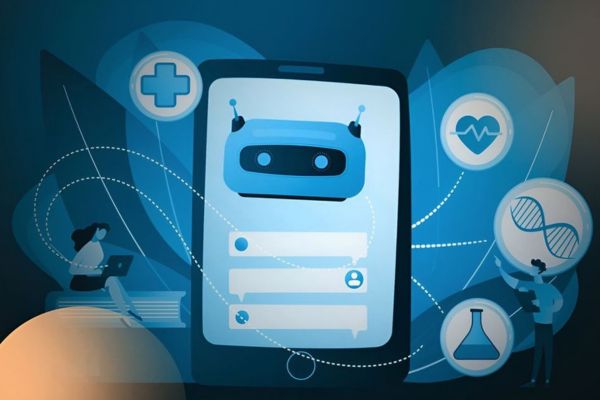The global healthcare chatbots market was valued at US$ 1.6 billion in 2024 and is projected to reach US$ 11.8 billion by 2033, reflecting a Compound Annual Growth Rate (CAGR) of 24.9% during the forecast period from 2025 to 2033.

Healthcare organizations around the globe are increasingly adopting real-time triage tools that streamline patient evaluation and alleviate administrative burdens. These tools, particularly healthcare chatbots, provide round-the-clock symptom analysis, accelerate care decisions, and enhance post-consultation support for patients. The integration of sophisticated AI models significantly enriches diagnostic insights, ushering in an era of highly responsive and data-informed patient engagement worldwide.
This advancement allows healthcare providers to offer more accurate and timely care, ultimately improving patient outcomes. Market leaders in the healthcare chatbots sector, such as Babylon Health (with its Babylon Chat), Ada Health (via the Ada App), Buoy Health (through Buoy Assistant), and Woebot (the Woebot chatbot), are recognized for their robust natural language processing (NLP) capabilities, user-friendly interfaces, and extensive symptom databases. These features contribute to their prominence in the market and their ability to meet the evolving needs of patients and healthcare providers alike.
Healthcare Chatbots Market Key Takeaways
- By Application, Symptom-checking applications are the most prevalent use case in the healthcare chatbots market, capturing over 39% of the market share.
- In terms of components, software is the backbone of the healthcare chatbots market, commanding over 64% market share.
- By End Users, Patients have quickly emerged as the largest end users in the healthcare chatbot market. Their growing reliance on these tools reflects the increasing demand for accessible healthcare support.
- When it comes to deployment, cloud-based solutions dominate the healthcare chatbots market, controlling over 65% of the share.
Regional Analysis
North America’s Leadership in the Healthcare Chatbots Market
North America holds a leading position in the healthcare chatbots market, boasting over 34% market share. This dominance is largely attributed to the United States’ robust digital infrastructure, effective healthcare funding mechanisms, and a base of enthusiastic early adopters.
- Major Health Systems Utilizing Bot-Driven Engagement: Prominent health systems, such as Kaiser Permanente, have successfully integrated bot-driven patient engagement strategies across at least eight states. This highlights the country’s commitment to optimizing clinical workflows and enhancing patient experiences through innovative technology.
- Technology Leaders Developing AI-Driven Healthcare Solutions: The presence of major technology leaders, including Microsoft, Google, and IBM, further strengthens the U.S. position in this market. These companies are at the forefront of developing AI-run healthcare solutions.
High Adoption of Healthcare Chatbots in the Asia Pacific Region
As of 2024, the Asia Pacific region is noted for its significant adoption of healthcare chatbots. This trend is largely driven by the presence of large patient populations and the rapid expansion of digital health solutions in the area.
- Benefits of AI-Powered Chatbots for Healthcare Facilities: Many healthcare facilities in the region have come to appreciate the ability of AI-powered chatbots to address common queries without the need for continuous human intervention. This operational model allows healthcare providers to improve efficiency and streamline patient interactions.
- Addressing Strain on Healthcare Infrastructure: The implementation of chatbots is particularly beneficial in densely populated areas, where the strain on healthcare infrastructure can be alleviated through efficient digital communication channels. By utilizing chatbots, healthcare facilities can manage patient inquiries more effectively, ultimately enhancing the overall patient experience.
Top Trends Escalating the Healthcare Chatbots Market
Widespread Use of Symptom-Checking Chatbots: The use of symptom-checking chatbots has become widespread in chronic disease management programs. These tools play a crucial role in helping patients monitor their conditions and access timely information, ultimately enhancing their overall care.
Rapid Expansion of Mental Wellness Chatbots: There has been a rapid expansion of mental wellness chatbots designed to provide personalized therapy sessions. These chatbots are increasingly utilized to offer support and guidance, making mental health resources more accessible to users.
Increasing Reliance on Predictive Analytics: The reliance on predictive analytics is on the rise, powering advanced chatbot-driven triage solutions. By analyzing data, these chatbots can provide more accurate assessments and recommendations, improving patient outcomes.
Escalating Demand for Automated Triage Solutions: The demand for automated triage solutions is escalating, particularly in decentralized healthcare structures. These solutions help streamline patient interactions and ensure that individuals receive appropriate care efficiently.
Growing Integration of Voice-Based Chatbots: There is a growing trend towards integrating voice-based chatbots into multilingual patient engagement platforms. This development enhances communication and accessibility, allowing healthcare providers to reach a broader audience.
Proactive Adoption of AI-Driven Diagnostic: Emerging telehealth services are proactively adopting AI-driven diagnostic aids. These tools assist healthcare professionals in making informed decisions and improving the quality of care provided to patients.
Healthcare Chatbots Market Segmentation
By Application
Symptom-checking applications have emerged as the most prevalent use case in the healthcare chatbot market, capturing over 39% of the market share. These applications effectively connect patients to rapid digital triage and provide timely advice, enhancing the overall efficiency of healthcare delivery.
Existing end users, particularly large telehealth ecosystems and pharmacy networks, have found these symptom-checking bots indispensable. The use of these chatbots can considerably reduce the volume of non-urgent inquiries. Thus, it allows healthcare professionals to focus on more critical patient needs and improve overall service efficiency.
By Component
Software is at the core of the healthcare chatbots market, commanding over 64% of the total market share. This software is essential in driving capabilities such as natural language processing, user interactions, and advanced analytics, which are crucial for the effective functioning of chatbots in the healthcare sector.
Leading developers in the healthcare chatbots market build upon these foundational software infrastructures by integrating additional features, including speech recognition. This enhancement allows for more intuitive user experiences and improved interaction, enabling healthcare providers to offer better services to patients.
By End Users
Patients have rapidly emerged as the largest end users in the healthcare chatbot market. Their dominance is largely attributed to the convenience offered by 24/7 symptom checks and the ability to receive immediate guidance. This accessibility allows patients to manage their health more effectively and efficiently.
Moreover, societal shifts towards telehealth and smartphone-based interactions have made healthcare chatbots indispensable across various demographics. From tech-savvy millennials to older adults, these tools have become essential in providing timely and relevant healthcare information, and enhancing the overall patient experience.
By Deployment
Cloud-based deployment has captured over 65% of the healthcare chatbot market, making it the preferred choice for healthcare providers. This approach allows for rapid deployment and ensures adherence to stringent data protection measures under frameworks like ISO 27001.
Many developers in the industry, such as Buoy Health, GYANT, Sensely, and Ada Health, utilize public cloud services like AWS and Azure. By leveraging these platforms, they can support high patient-load capacities without the need for on-premise infrastructure, thus enhancing scalability and efficiency in their chatbot solutions.
Recent Developments in the Healthcare Chatbots Market
- Octal IT Solution Leads AI Chatbot Innovation: In March 2025, Octal IT Solution, a leading AI chatbot development company, is at the forefront of the revolution with its advanced generative AI chatbots. These chatbots are designed to help healthcare providers optimize patient interactions, improve accessibility, and deliver personalized care through automation and intelligent conversations.
- Centific Secures National Agreement: In January 2025, Centific, a frontier AI data foundry company focused on accelerating businesses’ AI adoption through intelligent data management, was awarded a national group purchasing agreement for AI chatbots with Premier, Inc. This new agreement enables Premier members to take advantage of special pricing and terms pre-negotiated by Premier for Centific’s chatbots and AI scribes.
- Launch of ABDM WhatsApp Chatbot: In November 2024, the Central Government launched the Ayushman Bharat Digital Mission (ABDM) WhatsApp Chatbot, aimed at providing quick access to healthcare information directly through WhatsApp.
Global Healthcare Chatbots Market Major Players:
- Ada Digital Health Ltd.
- Babylon Healthcare Service Limited
- Buoy Health Inc.
- GYANT.Com Inc
- HealthTap Inc.
- Infermedica
- PACT Care BV
- Sensely Inc.
- Woebot Labs Inc.
- Your.MD Ltd
- Synthetix Ltd.,
- Other Prominent Players
Key Market Segmentation:
By Component
- Software
- Service
- Others
By Application
- Appointment Scheduling and Monitoring
- Symptoms Check
- Medical and Drug Information Assistance
- Others
By Deployment
- On-premise Model
- Cloud-based Model
By End-User
- Healthcare payers
- Healthcare providers
- Patients
- Other
By Geography
- North America
- Europe
- Asia-Pacific
- Latin America
- Middle East and Africa
Source: https://www.astuteanalytica.com/industry-report/healthcare-chatbots-market
















